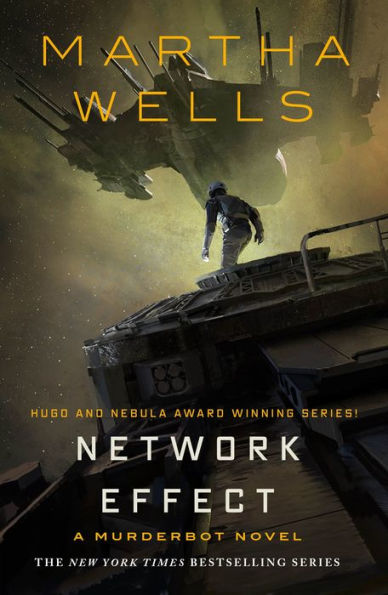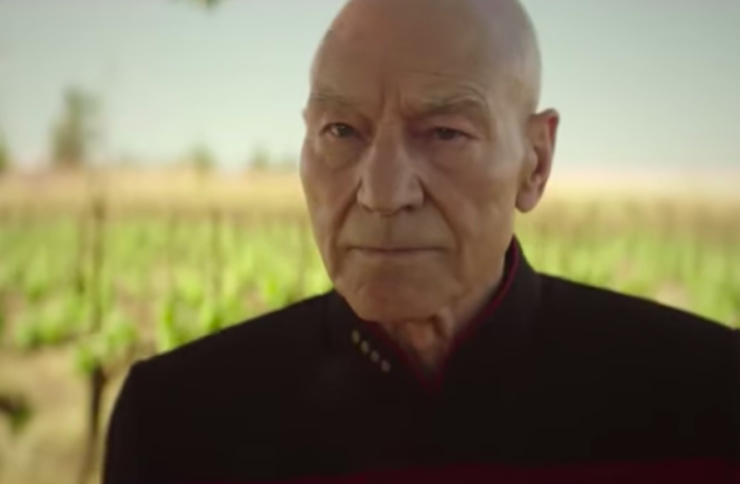The opening of Picard’s premiere episode is pure fan service: we’ve got the Enterprise-D flying through space just like it was on The Next Generation, we’ve got Data back in his old uniform, we’ve got Ten-Forward, we’ve got a poker game (a running gag that got its start in the episode “The Measure of a Man,” far from the last callback to that episode we’ll see in this first hour), and we’ve got Bing Crosby singing “Blue Sky,” which Data sang at the Riker-Troi wedding in Star Trek: Nemesis.
It’s all a dream, of course. But the fan service doesn’t end there….
(Full disclosure: Picard’s supervising producer, co-creator, and pilot co-writer Kirsten Beyer is a friend of your humble reviewer.)
As Trek pilots go, this is one of the better ones (certainly better than Discovery’s, which mistook backstory for introduction), though it helps that the protagonist is one of the most popular characters in Trek history (and, indeed, in pop culture generally), and so needs very little introduction.
It’s been just over two decades since the last time we saw Picard. This is the first long-form look at the post-Nemesis 24th-century since 2002, the only previous glimpses coming from Spock’s flashback in the 2009 Star Trek and “Children of Mars” a fortnight ago.
Thanks to the latter, we know one big thing that happened, and now we have the details of the attack on Mars that killed Kima and Lil’s parents: rogue synthetics destroyed Mars in a conflagration that is still raging a decade later. Apparently, work at the Daystrom Institute by Bruce Maddox (the cyberneticist who wanted to dismantle Data in “The Measure of a Man,” and who was later established as corresponding with him in “Data’s Day,” and who is name-checked here) resulted in more synthetics. (One wonders if the presence of Voyager’s EMH and his mobile emitter had a role in any of this as well, since he’s kind of a synthetic also.) After the Mars attack, however, synthetics were banned. Maddox himself has gone missing.
That attack happened shortly after the Romulan sun went supernova (as established in the ’09 film), and Admiral Picard’s rescue armada was discontinued, leaving many Romulan refugees screwed. Picard resigned in disgust, returning to the Picard vineyard in Labarre, France. (No word on Marie, Picard’s sister-in-law, who presumably would have inherited the vineyard and kept it going after Robert and Rene’s death in Star Trek Generations.) Two employees of the vineyard are Romulan refugees, played with country-manor dignity and delight by Jamie McShane (whom I just saw playing a drunk corrupt cop in my binge-watch of Bosch) and Orla Brady (late of Into the Badlands), and one wonders how many such Romulan refugees are performing menial jobs around the Federation now.
Buy the Book


Network Effect
The big change here in the twenty years since Nemesis is that the Federation is not living up to its ideals. Picard supposedly had to convince the higher-ups in the Federation to rescue Romulans displaced by the supernova, and a reporter to whom Picard has granted a live interview questions giving aid and comfort to “the Federation’s oldest enemies.” Well, the Federation has another nation that could be considered their “oldest enemies,” and when they had a catastrophe, the Federation went to their rescue and helped them out and they became a staunch ally. Of course, there were people who didn’t want the Federation and Klingons to become friendly, either, but just the fact that Praxis already happened a hundred years earlier makes this a bit—repetitive?
The flip side of this is that those who don’t remember history are doomed to repeat it, implied by the interview in which Picard references Dunkirk and the reporter has very obviously never heard of it.
I keep going back and forth on how I feel about these twin developments: the ban on synthetics and the treating of Romulan refugees as second-class citizens. Both of these are depressingly timely, especially the latter, but it also feels like ground that’s been trod before. The latter seasons of DS9, the third season of Enterprise, the first season of Discovery—they were all about wandering from ideals and needing to get back to them, and I just wish they’d dip into a different well.
On the other hand, who better to bring the Federation back to its ideals than Jean-Luc Picard, who’s already had to do that any number of times (“The Measure of a Man,” “The Offspring,” Star Trek Insurrection, to name but a few)?
I have no doubts, though, about how joyous it is to see Sir Patrick Stewart back in the saddle. After being stuck with Action Figure Picard in all the TNG movies, I’m grateful to see a return to the cerebral Picard of TNG’s earliest days, but with the more complex personality and maturity of TNG’s later days. He’s also very obviously older and more tired. At one point, he’s called upon to run up to the roof of a building, and he’s winded pretty much after the first ten steps. One of the things I’m most looking forward to about this series is a look at heroes in their twilight years, something not seen nearly often enough (and when done right, e.g., Unforgiven, and another Stewart vehicle, Logan, can be fucking brilliant).
There’s a lot of setup here, and some of the exposition comes a little too fast and furious. Picard’s leap from “I have a painting that looks like you” to “you’re an android!” is a bit far, and the only reason why the Daystrom Institute infodumps work at all is because Alison Pill’s Dr. Jurati is charming and snarky and delightful (by far the best performance in the episode, and that’s no critique of the other performances, Pill is just that good). Picard’s interview is a bit too constructed, feeling way too much like an attempt to channel Network’s climax by way of Aaron Sorkin, but Sorkin did it way better in the pilots for Studio 60 on the Sunset Strip and The Newsroom than the five writers of this episode (Beyer, Akiva Goldsman, James Duff, Michael Chabon, and Alex Kurtzman) manage. It doesn’t help that the interviewer is a tired stereotype of a muckracking journalist who promises not to ask Picard about why he left Starfleet and then proceeds to ask it anyhow, and also is a callow youth who doesn’t know her history.
I also have to confess to not being all that thrilled with the Data cameos. They’re dream sequences, and technology is good enough to almost convince me that this is the same Data from two decades ago, but it’s still so obviously digital and makeup fakery that it’s hard to take it seriously.
Isa Briones also creates very little impression as Dahj, who is yet another young woman who suddenly can kick ass, and the science fiction world definitely is not crying out for another one of those. Dahj, however, gets blow’d up real good—but she has a twin, Soji! So we’ll see more of Briones, at least, as Picard’s quest is now to find her, especially since the Romulans who were after Dahj (and who have already killed one innocent bystander, Dahj’s boyfriend) are likely also after Soji.
Picard also continues the Secret Hideout era of Trek’s skill with person-on-person combat, as the Romulans who ambush Dahj and Picard at Starfleet HQ use transporters as part of their attack strategy, beaming in and out to provide surprise (and also escape damage). It’s brilliant, something I’ve been waiting to see for five decades now, and it’s awesome. Bravo to all and sundry.
While the previews gave away that the Borg were going to be a part of this somehow, I have to admit to being surprised at the reveal at the end: the Romulans are using a hulk of a shut-down Borg cube as a refugee station. That’s where Soji is, as well as Narek, played with don’t-hate-me-because-I’m-beautiful soulfulness by Harry Treadaway. Given that both Jeri Ryan and Jonathan delArco are going to be reprising their roles as “cured” Borg Seven of Nine and Hugh, respectively, there’s more Borg-y action to come, which is—okay? I guess? I’m willing to wait and see before passing judgment, but my instinctive response to more Borg is a massive yawn.
The series has a lovely look, from the elegiac opening credits, to the pastoral beauty of the vineyard to the nicely designed future cities of Boston and San Francisco. Hanelle M. Culpepper—who is also a co-executive producer—creates an appropriately lived-in look for the series, one that has Trek’s trademark nostalgia for old things mixed in with cutting-edge technological wonders.
I also must give huge amounts of nerdy credit to the set designers of Picard’s “quantum archive” in Starfleet HQ, which is a futuristic safety deposit box that includes a bunch of nifty items from a model of the Stargazer (Picard’s first command, as seen in “The Battle“) to the banner for “Captain Picard Day” (from “The Pegasus“) to the d’k tahg from his time as Worf’s cha’DIch in “Sins of the Father” (as well as a bat’leth).
“Remembrance” is a good pilot, setting everything up nicely, and most of the problems I had with it are ones that might easily be addressed in future episodes. It’s always a joy to watch Stewart work, more so in one of his iconic roles, and enough was established here that I really want to know what happens next.
Keith R.A. DeCandido is also rewatching Star Trek: Voyager for this site, starting yesterday with “Caretaker,” and which will run every Monday and Thursday going forward. He’ll be reviewing each episode of Picard on Fridays throughout the first season. Look also for his rewatches of Star Trek The Original Series, Star Trek: The Next Generation, and Star Trek: Deep Space Nine, as well as his reviews of each episode of Star Trek: Discovery and Short Treks.










